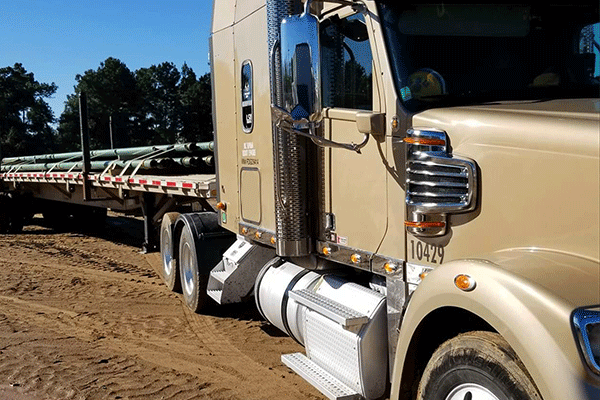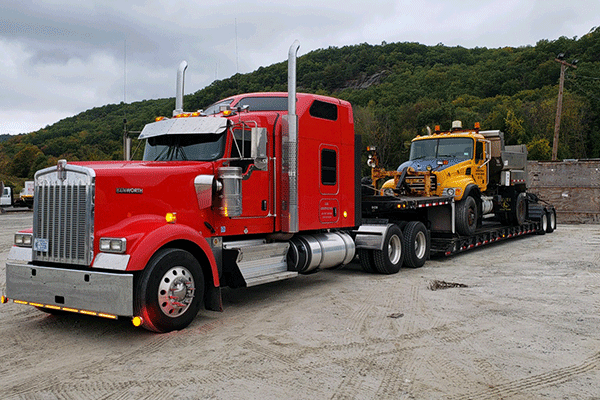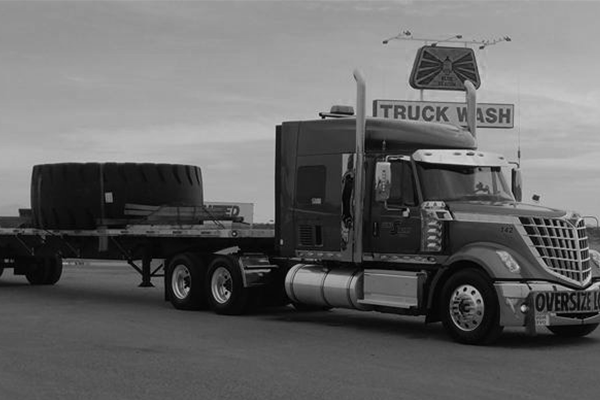The trucking industry is brimming with unique jargon. This can make starting in this industry or working with it overwhelming. As soon as you think you’re beginning to master the language of trucking, another term will pop up.
Anderson Trucking Services (ATS) has been in the trucking industry for seven decades, and we're ready to help you understand the various terms that are thrown around here.
That's why we’ve put together a list of 90 transportation definitions you need to know to navigate confidently throughout this industry.
This comprehensive guide will help to simplify some of the complex jargon and processes used in the trucking industry. And, since it's all collected in one place, you’ll be able to easily access this glossary at any time.
Below, we’ve separated the terms and phrases into these categories:
- Stakeholders
- Accessorial Charges
- Equipment Type
- Length of Haul
- Common Truck Terms
- Trucking Industry Cost Terms
- Other Common Terms/Phrases
Stakeholders
Asset Carrier: A shipping company that owns and operates its fleet of trucks.
Carrier: The entity in charge of carrying a shipment from its starting point to its destination.
Freight Brokerage: The intermediary between a shipper and the carrier (trucking company). Through the leveraging of pre-existing relationships, a freight brokerage works to find the best-fit capacity and ensure the successful transit of its customer’s freight.
Receiver/Consignee: The business/party who is on the receiving end of a shipment. Depending on the situation, the shipper and receiver may be the same.
Shipper: A business/party whose freight is being moved.

Accessorial Charges
Blind Shipment Charge: An accessorial charge assessed when the third-party, responsible for moving the shipment, is instructed by one stakeholder to withhold sensitive information about who they are from the other. ($100-$200)
Detention: A charge applied when a truck driver has to wait to be loaded or unloaded after arriving at the pick-up or delivery site. Industry standards stipulate that the first two detention hours are provided free of charge ($50-$75 per hour). Learn more about detention charges.
Driver Assist: If a driver is required to help offload cargo, this charge is applied. ($100-$150)
Hazmat: A charge for the transportation of hazardous materials. ($150-$500 depending on hazmat class and the lane)
Inside Pickup/Delivery: Commonly used for LTL shipments, this fee is applied if a driver needs to pick up or deliver freight that is not inside the specified loading zone. ($100 - $600)
Layover: Similar to a detention charge, a layover charge is applied at a flat rate when the shipper isn’t ready when the carrier’s truck shows up. Layover typically refers to wait charges when it takes more than one day to load/offload. ($250-$500 depending on equipment type)
Lumper: Third-party unloading services that charge a rate that is separate from the price quoted by a carrier ($50-$500+). Learn more about lumper services/charges.
Notification Before Delivery: Often the delivery timing of LTL frieght is difficult to predict as such, consignees sometimes want to know when their freight is nearing their facility, this charge is applied in these instances. ($50)
Over-Dimensional Cargo: A fee charged to the customer in charge of paying for the freight to cover all of the permits and fees associated with shipping any cargo that exceeds legal size limits. (Varies)
Re-consignment: This charge takes effect when your freight’s destination changes after the freight's already in transit. (Varies)
Stop Charge: A charge applied to every stop a driver has to make to fulfill a freight's delivery requirements. (Typically around $75-$100 per stop)
Tanker Endorsement: A charge applied when shipping 1,000 gallons of liquid or more in a dry van ($100-$1,000 depending on the lane). Learn more about tanker endorsements.
Tarp Charge: The charge levied when goods are moved using an open-deck trailer but need further protection from the elements using a tarp. ($100-$150)
Truck Order Not Used (TONU): A charge which pops up when a shipper orders a truck, but for one reason or another, doesn’t end up using the truck that was ordered. ($200-$600)
Equipment Type
Chassis: A special trailer that is used to transport ocean containers over the road. These are typically used in rail yards or shipping ports.
Conestoga: An open-deck trailer featuring an accordion-like retractable tarping system. Conestogas provide protection from the elements similar to a dry van trailer coupled with the ease of loading/unloading offered by an open-deck. Learn more about Conestoga trailers.
Dry Van: Fully enclosed shipping trailers typically measuring 53’ in length. Dry Vans are the most common type of trailer, used to transport most consumer goods and commodities.
Double drop/Lowboy: The name that is given to the open deck trailer with heightened front and back ends and a lower-middle well area that usually measure between 26 and 30 feet in length. These trailers are often used to help keep a load within legal height limits.
Drop-deck/Step-deck: An open deck trailer that is commonly used as an alternative to the flatbed trailer when the height of a load is a factor. The trailer is comprised of an upper deck and a lower to the ground rear section. The lower section provides up to an additional 19” of available loaded height, allowing taller pieces to travel within legal height restrictions.
Extendable Drop-deck: A specialized drop-deck trailer with an extendable middle section to haul longer, taller freight.
Extendable RGN: A removable gooseneck trailer that can be extended much like an extendable drop-deck. These trailers provide an excellent solution for large construction and agricultural equipment by providing extra height and length capacity for larger freight.
Flatbed: The traditional open deck trailer, free of frills and complexity. Flatbeds provide continuous open loading space typically ranging between 48 feet and 53 feet in length.
Hot Shot: A smaller trailer that can be hauled using a class 3-6 pickup truck. Because of their small size, these trailers come with a limited weight capacity. Learn more about hot shot trucking.
Jeep Dolly: Shorter trailers that include a sliding fifth wheel, kingpin and a system of suspension. These 1-3 axle units are used as the intermediary between the main trailer — hoisting the load — and the tractor.
Low-profile Step-deck: A step deck trailer that is closer to the ground than traditional step-deck trailers (typically provides 6 inches more height capacity than a traditional step deck trailer).
Mini-Deck RGN: Similar to a Double Drop/Lowboy but lower to the ground. These trailers are typically used to reduce the overall height of a shipment to meet legal requirements for exceptionally tall loads (typically offer 6 more inches of loading height than a traditional double drop trailer).
Reefer: A temperature-controlled trailer used to transport refrigerated/frozen goods. Learn more about reefer trailers.
Removable Gooseneck (RGN): A term used to describe a trailer whose gooseneck (used to connect the trailer to the truck) can be removed. This creates a ramp to be used in the loading/offloading of large machinery.
Stinger Dolly: The 1-3-axle rear units attached immediately following the main trailer. These “stingers” — also called “tail-waggers” — are a common piece of equipment used to assist the transport of heavy loads.

Length of Haul
Length of Haul (LOH): The distance, typically in miles, that a shipment will travel. This is a common phrase used to determine pricing and capacity options for a shipment based on the distance.
Short-Haul: Any shipment measuring 249 miles or less.
Mid-Haul: Any shipment measuring between 250 and 400 miles in total length.
Tweener: A term used to identify the LOH associated with the distance range of 401-800 miles.
Long-Haul: The LOH that is associated with the distance range of 801-1200 miles.
Extended-Long: Any shipment spanning a distance greater than 1200 miles.
Common Truck Terms
5th Wheel: The plate located at the back of a semi which is used to attach the truck to the trailer it will be hauling.
Bunk: The area where a truck driver sleeps during longer hauls.
Cab: The place where the driver sits when hauling a shipment.
Chains: A common method for the securement of freight on an open deck trailer.
Commercial Drivers License (CDL): The license that is required to drive any truck with a GCWR of more than 26,000 pounds or a GVWR of greater than 10,000 pounds.
E-log (ELD): An Electronic Logging Device that must be used by all truck drivers unless they fall into specific exemption categories. By using an E-log, drivers can ensure their compliance with all governmental hours of service regulations.
Headache Rack/Headboard: A metal barrier station positioned behind the cab of a semi-tractor that is used to prevent freight from shifting forward and harming the equipment or anyone inside.
Kingpin: The hitch located at the front of a trailer that slides into the 5th wheel of a truck.
Landing Gear: The support system that is deployed while a trailer is detached from a truck. While in transit, the landing gear is retracted.
Load Bars: A telescoping bar used to secure cargo and prevent shifting in a van trailer.
Load Straps: Belts made of canvas that are used to secure a load onto the deck of a trailer.
Load Binders: A chain tensioning device used to bind, clamp, anchor or tie down large cargo loads for transport.
Load/Corner Protectors: Wedge-shaped protectors used to prevent the damaging of freight from the pressure of securement devices like straps, binders and chains. These protectors are typically made of plastic or metal.
Motor Carrier Number (MC#): The number that carriers must possess to cross state lines. This number also functions as a way for the government to track carriers in their systems.
Placard: Warning signs that are placed on all four sides of a trailer that is carrying hazardous materials.
Tractor: A common industry term referring to the truck/semi carrying the trailer.
Trucking Industry Cost Terms
Cents Per Mile (CPM): The calculation of a shipment’s cost per mile. Commonly used in conjunction with RPM.
Collect on Delivery (COD): The collection of payment on the freight being shipped upon its arrival. Usually outlined in a shipment's BOL.
Contract Rates: The rate that a transportation provider agrees to charge for a set lane over a period of time.
Fuel Surcharge (FSC): A cost that factors into the overall cost of moving freight based on the US National Average Fuel Index which is published weekly. Learn more about fuel surcharge schedules.
Rate Per Mile (RPM): Rate Per Mile (RPM) is trucking industry jargon regarding the pricing of a shipment on a per-mile basis.
Spot Market: The pricing structure applied to freight at any given time based on the current market price. Typically used to price shipments that are not billed on a contract rate.
Other Common Transportation Terms and Phrases
Back-haul: A load that will get the carrier back to where they want to be, the process of getting a truck “back” from its ending point.
Blind Shipment: The process of withholding information regarding the pickup location from the receiver and the drop-off location from the shipper.
Bill of Lading (BOL): A receipt of freight services that serves as a record of the chain of custody for a shipment. The BOL is a legally binding document providing the driver, carrier, shipper and receiver all details needed to process the freight shipment and invoice it correctly.
Bobtailing: When a truck drives without a trailer attached to it.
Common Carrier: A carrier that is not dedicated to a single company but is openly “for hire.”
Contract Carrier: A company that carries their customers' freight as stipulated by a written agreement.
Dead-Heading: A situation where a carrier is forced to drive with an empty trailer.
Dedicated Truck: A truck that is dedicated to a specific customer’s freight and no one else's.
Drop Trailer Service: A service where a truck driver will “drop” or leave a trailer at the receiver’s facility so that they can load or unload at their convenience. Learn more about drop trailer programs.
Federal Motor Carrier Safety Association (FMCSA): The branch of the Department of Transportation that is dedicated to overseeing the trucking industry.
First Come First Serve (FCFS): Refers to a shipper’s or receiver’s priority in the order of arriving trucks to be loaded or unloaded. FCFS is based solely on the order in which they make it to the location. Learn more about first-come-first-serve.
Force Majeure: The stipulation in shipping contracts that removes a party's liability if they are unable to perform due to an unpredictable disruption (i.e., natural disaster, extreme weather, acts of terror, etc.).
Freight Forwarder: Facilitates the shipment of goods for a third party. A freight forwarder is similar to a freight broker but typically handles international goods. Learn more about what freight forwarders do.
Gross Combined Weight Rating (GCWR): The total weight rating of combination vehicles, such as that of a semi-tractor and its trailer. GCWR can be calculated by adding the GVWRs of all combined towing units.
Gross Vehicle Weight Rating (GVWR): The total amount of weight a vehicle is manufactured to safely haul. GVWR is a set number, specific to each vehicle, takes into account a vehicle's curb weight, and doesn't change based on the weight specifications of any complimentary trailers.
Heavy Haul Freight: The term that's given to a load that exceeds governmental restrictions in some way be it: weight, length, width or height. These shipments must be moved using special routes and equipment.
Hours of Service (HOS): The amount of time that a driver can legally be “on duty.” Hours of Service are calculated to include both drive time and the break periods specified by the FMCSA. Drivers are allowed 14 hours of “on-duty” time, this includes their 11 hours of allowed “driving” time. Learn more about HOS regulations.
Intermodal: The transport of freight using multiple modes of transport. Often, this means transporting freight using rail, boat and truck.
Lead Time: The amount of time a carrier is given to arrange for the shipment of freight. Lead time is directly tied to the urgency with which a shipper needs their materials transported.
Less-Than-Truckload (LTL): A term used when the freight hauled is smaller than the full capacity of the truck carrying it.
Load Tender: The official offer extended to a carrier by a shipper. These documents typically include information about scheduling, the equipment required, the commodity being moved and any other special instructions.
Over-Dimensional: Freight whose size exceeds the maximum legal dimensions on its given route.
Over-The-Road (OTR): The term used to describe truck drivers who move freight for extended periods of distance and time.
Pilot Cars: A vehicle that accompanies a Heavy Haul shipment moving over the road. These cars often utilize flashing lights and signage to indicate their presence.
Power Only: Providing the truck/tractor needed to haul a trailer but not the trailer itself. Learn more about power-only trucking.
Re-power: The process of supplementing a new truck to haul a trailer to get the freight moving again. This is often done when the previous truck hauling the load is sidelined for any number of reasons
Shipping Lane: The route that is routinely served by a carrier specific to a start and ending point.
Team of Drivers: Two drivers who work in tandem to haul freight for an extended distance when time is of the essence. Using a team of drivers, although more efficient, comes at a heightened price point for a shipper.

How to Use These Trucking Terms
You now have a better understanding of each of these terms and the role they play in this massive industry. Bookmark this page so that you always have access to them in the future.
A well-educated supply chain is a fruitful supply chain. Use this glossary as a tool in your future purchasing decisions so that you can make the most of your shipping budget.
ATS Logistics has a long history of helping its customers grow and their supply chains thrive. If you have any further questions, please don’t hesitate to reach out. We’re always happy to help.




